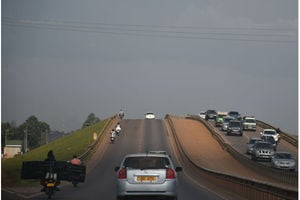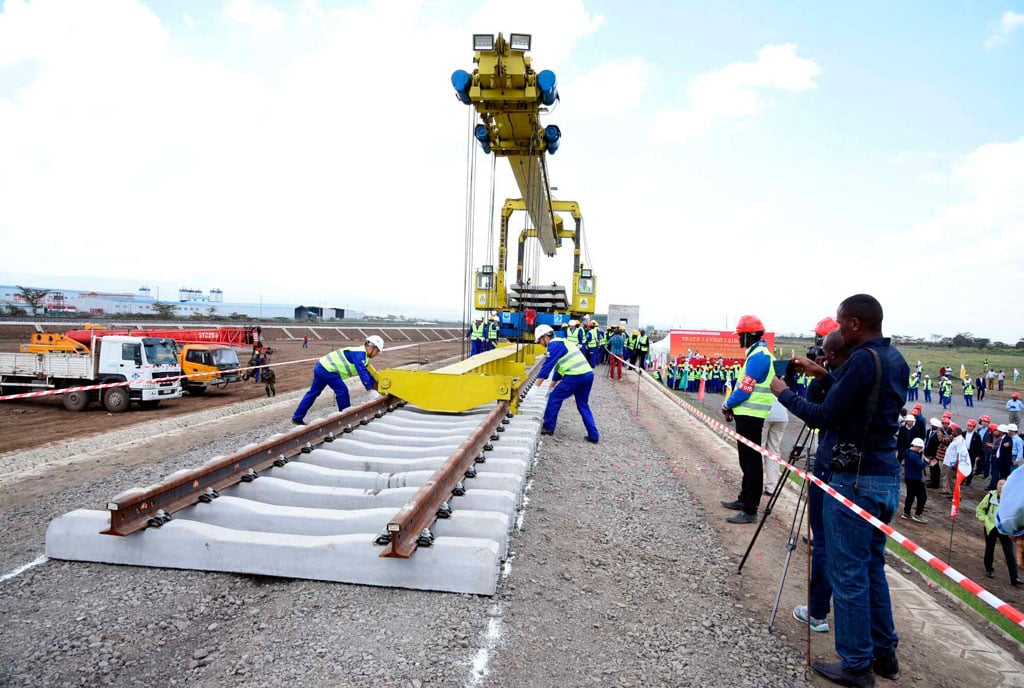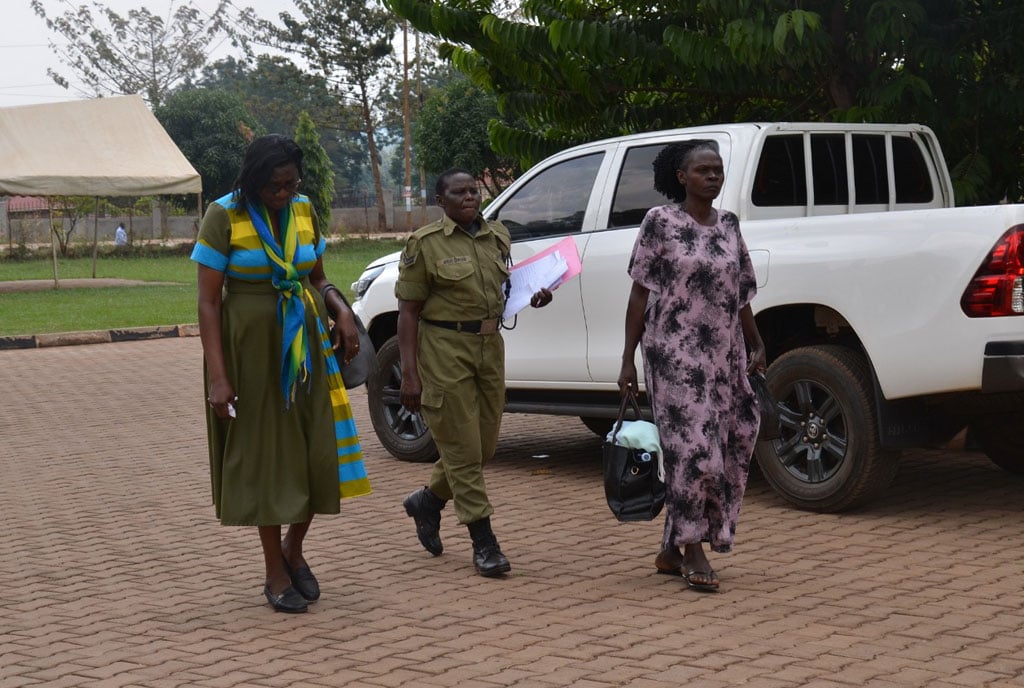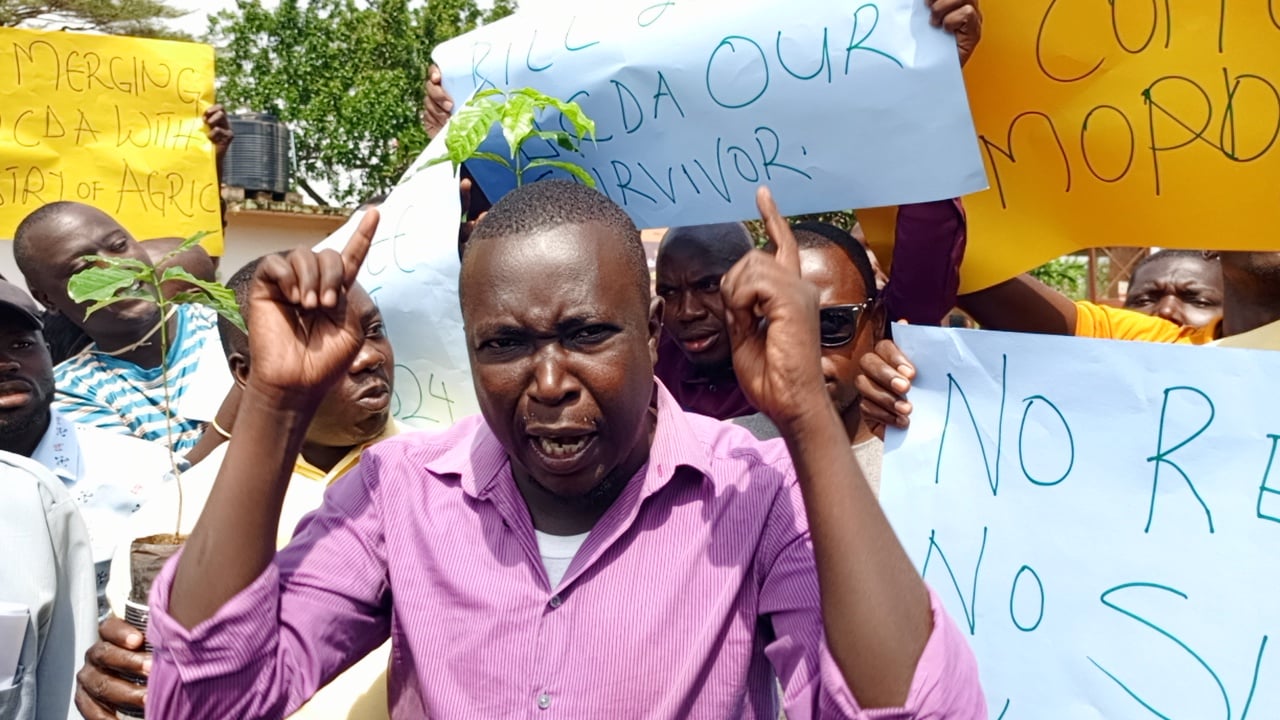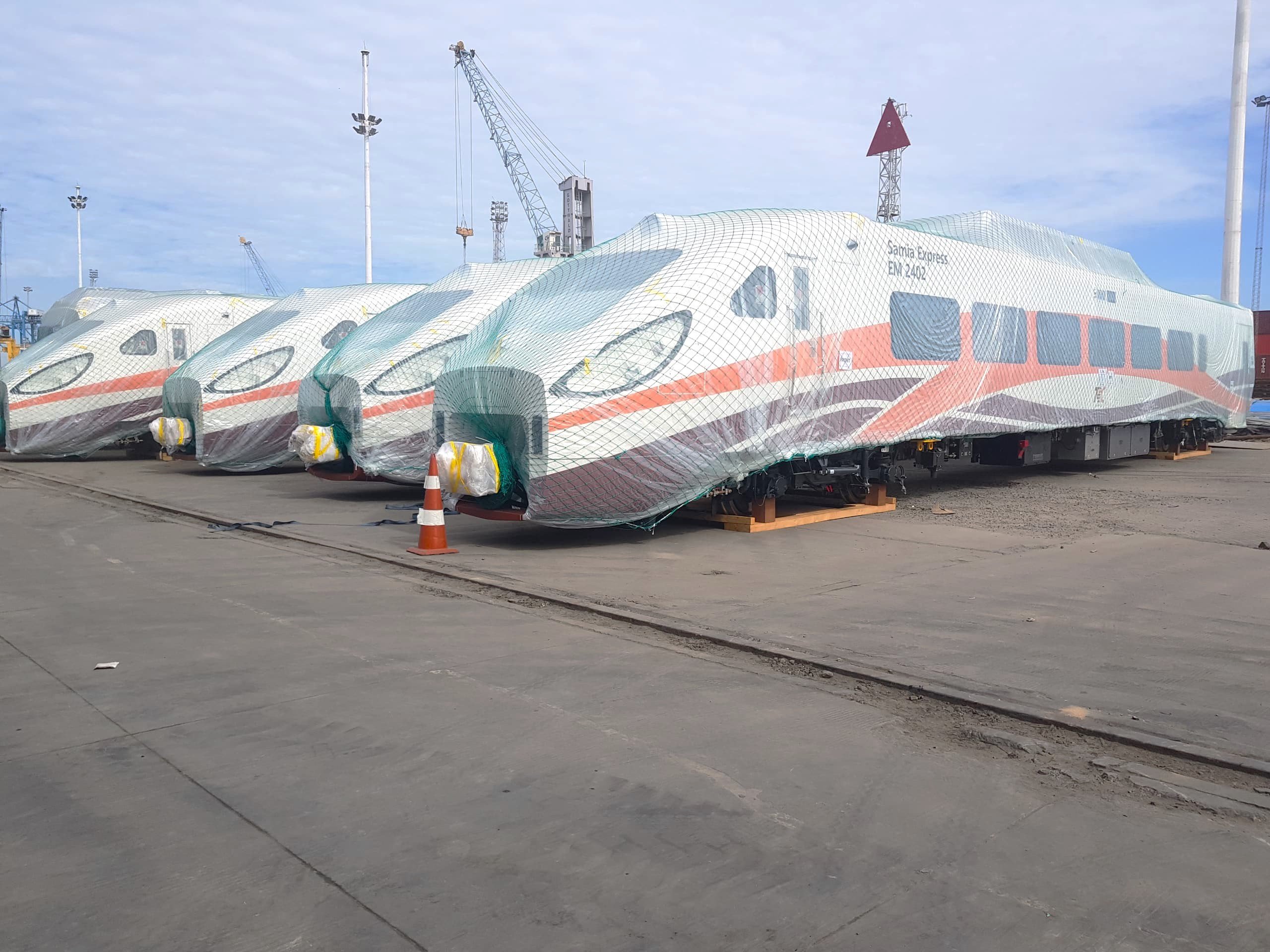
Tanzania's new electric multiple-unit (EMU) trains. PHOTO | COURTESY
Tanzania this week officially launched passenger train services on its new electric Standard Gauge Railway (SGR) connecting the port city of Dar es Salaam with the administrative capital Dodoma in the central region.
President Samia Suluhu Hassan, who flagged off the train on Thursday before hopping in for a ride to Dodoma, sees it as a launchpad of regional connectedness by rail for ease of movement of people and goods, trade and better economies.
The inauguration came as Uganda formally listed Turkish firm Yapi Merkezi to help build its own SGR stretch from Malaba on the Kenyan border to Kampala.
At the same time, Kenya said it was bringing under its direct management SGR operations between Mombasa and Naivasha from the Chinese from next year, even as it looks to Beijing to help fund the line to Malaba.
Kenya Railways Corporation (KRC) has assumed 90 percent of the operations of the SGR line from the Chinese firm Africa Star Railway Operation Company (Afristar) ahead of a full takeover in June 2025, as part of a plan to reduce soaring operational costs that have become a matter of public concern.
KRC Managing Director Philip Mainga said the handover process is going on and, as per the initial plan, the last function was scheduled to be handed over by December 31, 2025.
“However, the KRC management is in discussion with Afristar to hand back all functions by June 2025,” he said.
The initial timeline for the completion of the takeover process was May 2022.
In Dodoma, President Samia was candid about seeing her railway, an important conduit for trade from Dar es salaam port to countries such as Burundi, Uganda, Democratic Republic of Congo and even Rwanda, get to its final destination.
The aim is to ensure that the project aligns the business of the port with the Great Lakes region and links the railway to the airport in Dar, she said, envisaging a line in the future going direct to the Julius Nyerere International Airport’s Terminal 3.
The train service from Dar es Salaam to Dodoma cuts the travel time to three hours and 25 minutes, compared with about eight hours by bus, but the SGR service may need critical attention, especially around electricity supply.
Ahead of the launch this week, a train got stuck on its way to Dodoma due to a power failure. Tanzania Railway Corporation (TRC) blamed wild animals for “interfering with the electric cables.”
But such power outages have been frequent in the country and could ruin travel schedules for people or goods on delivery.
Tanzania's State power utility Tanesco had earlier said it would supply 70MW to power the first phase of the line. The country has more power (2,000MW) than it needs for now (1,800MW), but the challenge has been its distribution.
Beyond that, ongoing projects to renovate inland ports should be completed before the SGR itself is done.
President Samia is pegging the success of those ports to the functionality of the SGR, and vice versa.
When fully functional, this line is expected to ferry some thousands of tonnes of goods a year. It will also ferry about 7,000 passengers per day, according to TRC estimates.
In Kampala, even as it continues to scan the external debt markets for financiers for its SGR project, the Ugandan government this week indicated it was poised to start construction of the 273km Malaba-Kampala line before end of this year, riding on a $600 million budget allocation to fund completion of land acquisition, equipment mobilisation and early civil works.
Project negotiations
This comes after completion of project negotiations between Uganda government and Turkish firm Yapi Merkezi – the apparent contractor – with the contract now before the Attorney General for approval and expected to be signed in “three weeks’ time,” SGR Project Coordinator Eng Perez Wamburu said.
“We are at the tail end of the procurement of Yapi Merkezi. We have discussed the costs and we are at the bottom line of agreeing that we shall have the contract after it has been approved by the Attorney General. We hope to start before the end of this year,” Eng Wamburu told a media briefing on Wednesday.
In an interview with The EastAfrican Thursday, he declined to divulge the value of the contract, saying: “Yapi Merkezi has given us the proposal of what this project could cost. In a maximum of three weeks, we will share what the cost is and thereafter have the contract signed.”
Attorney General Kiryowa Kiwanuka also declined to reveal details of the contract ,which has been under discussion for more than a year, saying there will be unnecessary attention on the project and the parties.
“We cannot reveal that until the review process is complete. All I can say is that this contract is with the Deputy Attorney General, the process is at an advanced stage,” Mr Kiwanuka said.
But it is understood that the working figure that Yapi submitted to construct the 230km of the main track and another 40km of sidings and related infrastructure is higher than the $2.3 billion that China Harbour and Engineering Corporation (CHEC) originally quoted in 2015.
The figure was revised to $2.2 billion in the contract review as “addendum 2” in 2019, which slashed the original contract value by $120 million but added a 2km annex-rail link at the Kampala Business Park Namanve.
Last year, Uganda government severed the CHEC contract, whose award was tied to Kampala getting the project’s financing from the Exim Bank of China, and when this failed, it made it easy for the parties to disengage from the agreement.
The rise in total cost of Malaba-Kampala, sources familiar with the negotiations said, was due to global uptick in the cost of equipment, land prices along the urbanised Kampala-Jinja section.
But The EastAfrican has learnt that the Uganda-Kenya joint sourcing for financing is yet to land concrete offers, with a delegation from Nairobi expected back in Beijing this month, and Ugandan officials are expected to tag along, as the two countries seek to link their SGR projects for commercial viability.
At the same time, Uganda is still pursuing the Yapi Merkezi financing model via export credit agencies that the Turkish firm floated, with backing from major global lenders that the company has established to frontload project funding to its clients.
“The meetings between May last year and now agreed on joint financing but with different options,” says Eng Wamburu. “Kenya is still trying with China. That’s one option. Or they can come to us and we pursue the Uganda option of export credit agencies.”
On Friday, Nairobi maintained that despite Uganda settling on their preferred investor, it is still exploring on more options to give Kenyans the best deal.
Transport Principal Secretary (PS) in the Ministry of Roads and Transport Mohammed Daghar said: “We are still exploring our choices in China, Turkey and other partners who can come on board to develop the railway, but we are yet to settle on one.”
The PS did not confirm or deny that they would engage Yapi Merkezi, noting that Kenya would engage whoever offers the best deal at the lowest cost. Kenya has estimated the cost of constructing the line from Naivasha to Malaba at $5.3 billion. The project has been in limbo for over five years.
In 2019, then Kenyan President Uhuru Kenyatta, on his fourth trip to China, failed to secure $3.68 billion to fund the third phase of his signature SGR project to extend to Kisumu, then to Malaba.
The Northern Corridor partners -- Kenya, Uganda, Rwanda and South Sudan –- undertook in 2013, to build a connected railway system as a more efficient mode of transport that would by 2018 replace the century-old metre gauge railway to improve the corridor’s logistics value chain.
They approached China Exim Bank for loans that would be repaid with revenue from cargo business, as SGR project executives sold Beijing rosy return on investment numbers but the Chinese insisted on an economic matrix which Uganda did not immediately address.
Some of the conditions included adoption of similar Chinese rail class standards, seamless connectivity of the SGR rail lines, a management firm to run the operations of the business and a robust loan repayment method.
As Uganda and Kenya did not guarantee their lines linking at Malaba due to Kenya’s SGR initially stopping in Nairobi, Kampala and CHEC were kept on a waiting game, with only land acquisition along the corridor as the main activity of the project.
This financial year, Finance Minister Matia Kasaija announced that government’s focus would go beyond land acquisition and be put “on commencement of construction of the Standard Gauge Railway” for which he allocated Ush2.21 trillion (about $600 million) for this purpose.
Officials also said that by handing the job to Yapi Merkezi – a European firm – Uganda will now adopt Arema (American Railway Engineering and Maintenance-of-Way Association)/European standard and ditch the China Class 1 Standard that Kenya adapted for its SGR infrastructure.
The development also means that, along with Tanzania, which has also contracted Yapi Merkezi for sections of its SGR, Uganda becomes the second country in East Africa to deploy Arema standards, while Kenya deploys China Class 1 standard.
But officials explained that regardless of the different railway classes, seamless connectivity is still guaranteed provided the contractors will synchronise the rail systems.
“If you maintain the same specifics, none of these is superior to the other. The contactor is in the know. You only have to harmonise certain aspects,” said Eng Wamburu, citing the case of Ethiopia, where a Chinese contractor built a China Class 2 standard SGR while Yapi built another – the 390km Awash-Kombolcha-Hara Gebaya line – to Arema standard, in the north of the country.
Meanwhile, Tanzania’s SGR has given the 1,300km Central Corridor a fresh impetus in the scramble for business with the 1,700km northern route.
“By connecting to the DRC, we aim to boost regional trade, allowing us to trade directly within Africa rather than exporting to distant markets,” President Samia said in Dodoma on Thursday.
“The disconnection within Africa's infrastructure — railways, roads, seas, and aviation —restricts trade and forces us to rely heavily on foreign markets.”
The Tanzanian leader stressed that improved SGR connectivity would benefit sub-sectors such as coffee and cassava farming in direct trade opportunities within Africa, avoiding international price pressures.
But she managed expectations among Tanzanians on the potential revenues from the project, saying, “While initial profits may not be immediate, the focus is on the long-term economic benefits and development spill-overs.”
Tanzanian officials are upbeat about the new railway. They have cited the recent trend where tourists are moving inland from Dar es salaam on the SGR, potentially avoiding road accidents and delays. That could hurt road transporters, though, but it is a safe means for tourist travels.
Speaking in Dodoma, TRC director-general Masanja Kadogosa said the government would spend $10.53 billion (Tsh25 trillion) to build the SGR in its entirety.
He said the Dar es Salaam-Morogoro-Dodoma routes have attracted an average of 7,000 passengers per day.
“We anticipate growing passenger numbers as people from cities like Mbeya, Arusha, Mwanza and Iringa use the SGR to reach Dodoma and connect to final destinations,” Mr Kadogosa said.
As Tanzania pushes forward with its SGR expansion plans, the country aims to strengthen regional trade ties and stimulate economic growth across Africa. Analysts say completing the project in its entirety would boost the transport sector and act as a catalyst to the economy of Dar es Salaam port.
“SGR will be a catalyst for cargo transportation for the aforementioned countries because both are the largest cargo transit transporters from Dar es Salaam port to other African countries,” Dar es Salaam-based economist Oscar Mkude told The Citizen.
Connecting the project to the DRC and Burundi would help Dodoma repay the money borrowed to develop the project on time. This is because the DRC, along with Zambia, account for the largest share of goods in transit that pass through Tanzania’s ports.
“It means that the government will get its return on the construction costs within a short period, though that will depend on raising efficiency at the Dar es Salaam Port as well as reducing charges and issues related to taxes,” Mr Mkude said.
Dr Wilhelm Ngasamiaku, a senior lecturer from the University of Dar es Salaam, also told The Citizen that the SGR was important for the economy.
“Once SGR is connected to Burundi and Congo DRC, it will boost cargo transportation, open the economy of the country, and open the economies of countries in the Great Lakes,” he said.
The SGR is, in fact, a regional ambition. Kenya, which began the project ahead of peers, has been stuck in the mud of debt, and lack of financing for extension. It somewhat entangled Uganda, which has tried to avoid Chinese debt.
This week, KRC disclosed that it has taken over 90 percent of the SGR functions from Afristar, with plans underway to take over the signalling function by December this year which will reduce reliance on the Chinese firm to about six percent.
“The system is now run by Kenyans with localisation standing at 87 percent. This is subject to change in December when the corporation takes over the function of signalling, hence reducing reliance on Chinese to about six percent,” Mr Mainga said.
After many years of loss-making, the government decided to concession the freight and passenger rail services and, subsequently, the KRC Act was amended to allow the provision of rail services through concession.
“When we took over the entire meter gauge operations from RVR, we inherited up to 1,280 employees. The size of the payroll is within our target of 30 percent staff cost as a ratio of revenue,” the MD said.
In November 2006, the government and Kenya Railways signed a concession agreement with RVR Ltd for freight and passenger services.
But this concession was legally terminated on July 31, 2017 due to the failure by the concessionaire to meet its obligations as set in the concession agreement.
Following the exit of RVR in August 2017 there was significantly reduced income from concession fees revenue stream.
But there were new revenue streams with the metre gauge railway services reverting to KRC and SGR being operationalised.
KRC awarded Afristar, which is owned by China Road and Bridge Corporation (CRBC), a subsidiary of the majority Chinese state-owned China Communications Construction Company (CCCC), a 10-year contract to operate and maintain the Mombasa-Nairobi-Naivasha line, which runs 592 kilometres.
The agreement excluded KRC from collecting revenues from sales and the operational costs later jumped beyond the roof with government data showing that taxpayers were forking out close to Ksh1 billion ($7.7 million) per month on the running of the railway line which resulted in accumulated pending bills of more than Ksh38 billion ($292.3 million) mid-2020.
The agreement included a provision for the revision or termination of the contract every five years and KRC chose not to continue the contract at the end of the initial five-year period ending in May 2021.

